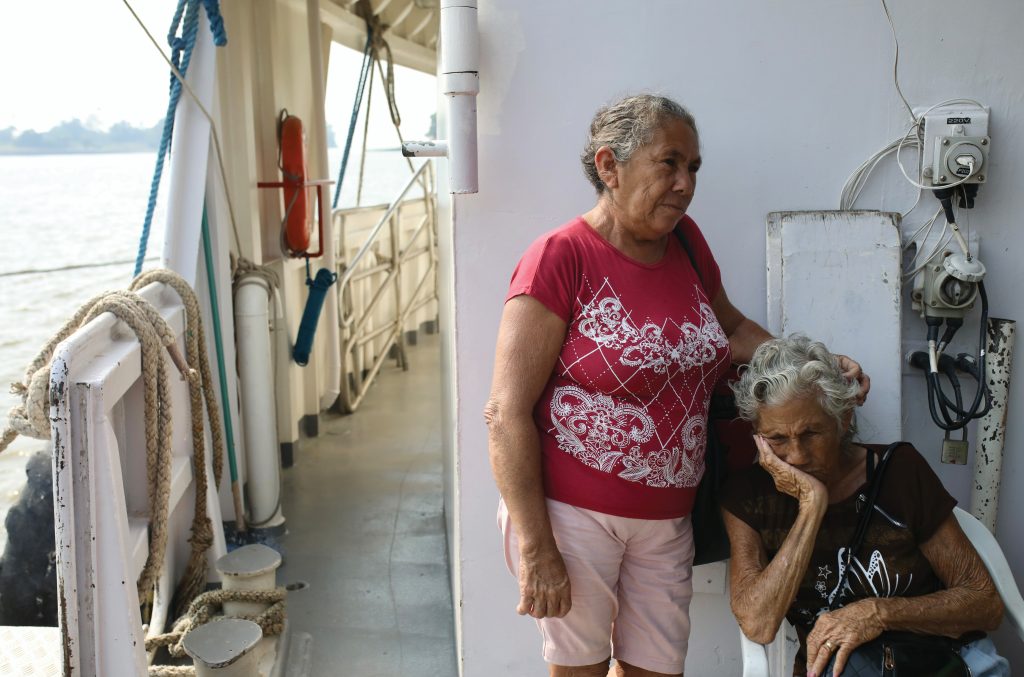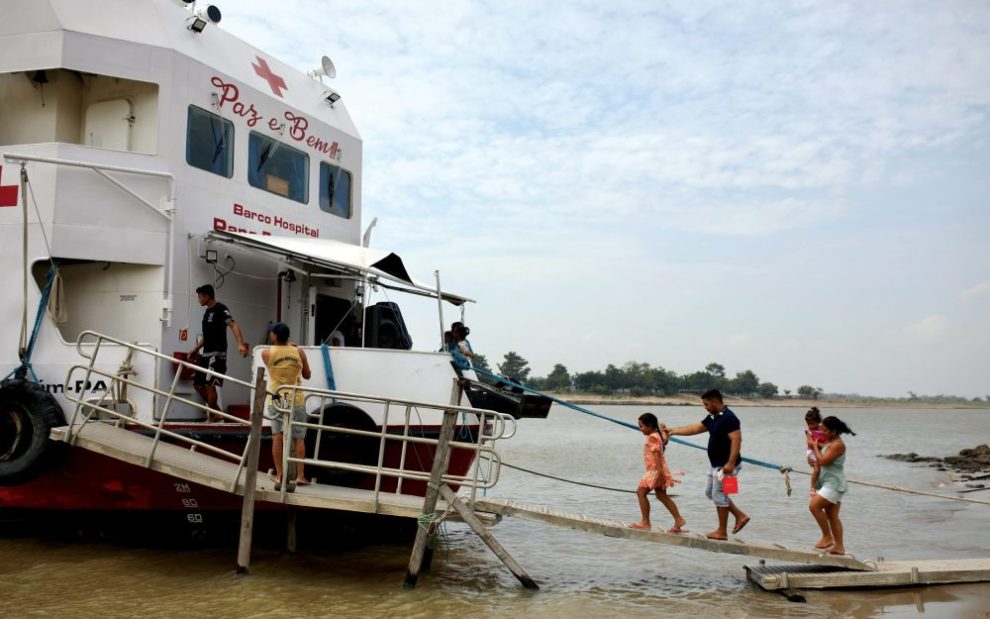Tears pour down Luiz Mateus Dos Santos’ face as the Brazilian farmer tries to articulate his gratitude to the Pope Francis hospital boat. A short, muscular man with graying curly hair, Dos Santos has been unable to work for two years due to crippling pain from a hernia. When the 52-year-old heard about the hospital boat that navigates the rivers of the Amazon rainforest, he jumped at the chance to receive medical care. Sitting in the post-operative room where he spent the night recovering, waves of emotion crash over him as he contemplates past pain and the fresh feeling of hope.
Dos Santos is just one of hundreds of patients the Pope Francis hospital boat helped during its November 2023 six-day stay in Pariço, a small community of 3,000 inhabitants on the Amazon River located between the cities of Manaus to the west and Belém to the east. Founded by the Fraternity of Saint Francis of Assisi in the Providence of God, the boat visits an average of two communities each month, bringing specialized medical services to populations that are largely deprived of them. Eighteen doctors—general practitioners, surgeons, an ophthalmologist, a pediatrician, and a radiologist—were part of the expedition in Pariço, all volunteers from São Paulo State.
Like many other patients with hernias in Pariço, Dos Santos developed the painful lump following a life of heavy lifting. He farms corn, beans, and tomatoes. With seven children between the ages of 3 and 22 to feed, the decrease in income due to his injury was particularly devastating. Dos Santos criticizes the lack of health services in the region, which he says has sometimes resulted in premature deaths. “How many people have died for want of this boat?” Dos Santos asks, his voice cracking.
Health care is safeguarded as a free and universal right in the Brazilian constitution, but across the country, inequalities in access are deeply entrenched. The Pope Francis boat operates in the state of Pará, which covers an area approximately the size of Peru. Pará has the lowest ratio of doctors to patients, with 1.18 doctors per 1,000 inhabitants, according to a 2023 study by the University of São Paulo. Patients can sometimes wait years to see a specialist within Brazil’s public health system.

“The hospital boat brings relief to people who need it,” says Paulo Roberto Rodolfi, as he leans against a protruding rock on the shore, river dolphins coming up for air behind him. Rodolfi, a nursing assistant, is part of the local team that came to assist the hospital boat during its stay in Pariço.
Funded by both the national health care system and donations, the boat traces its origins back to 2013, when World Youth Day—a global gathering of young Catholics—was held in Rio de Janeiro. Pope Francis asked a friar in the Fraternity of Saint Francis of Assisi in the Providence of God if the organization was present in the Amazon. A negative response came, to which the pope replied, “Then you must go!” Six years later, the boat set sail for the first time.
Religious institutions in Brazil have a long history of providing health care services. For Paulo de Tarso Ribeiro de Oliveira, a former hospital director and professor at the Federal University of Pará, the intertwinement of religion and health is not an issue so long as patients are treated equally and there is no proselytism. “If they don’t make political use of the boat, I don’t see a problem,” Oliveira says.
Friar Afonso Lamberti, who trained as a dentist, organizes and participates in every expedition. Seated behind a desk in his cabin-office-bedroom on the boat, where a sober cross hangs on the wall, Lamberti explains that the boat is not used for evangelization. But Christian values permeate the boat’s mission. Lamberti, who is dressed in a brown habit, explains that the institution draws its inspiration from Pope Francis’ oft-repeated discourse that the church should not wait for people to come to it. “The church needs to go toward people who need it, like Jesus did,” Lamberti says.
The largest rainforest in the world, the Amazon spans more than two million square miles. While its inhabitants are clearly in need of better health care, the rest of the world also needs those who live in the Amazon. Indeed, experts have demonstrated that protecting the health of populations inhabiting the region is also a means of protecting the forest in which these people live—one of the planet’s richest biomes, often termed the “lungs of the world.” Bringing health care services to riverside communities and Indigenous populations allows them to remain on-site, rather than having to seek care in faraway cities. The presence of health care facilities serves as a deterrent to illegal land grabbing, which is typically followed by deforestation to make way for cattle ranching.
Under former far-right president Jair Bolsonaro, deforestation soared to a 15-year high. More than 14 million acres went up in smoke during his administration (2019–2022). While deforestation rates have dropped since left-wing President Luiz Inácio Lula da Silva took office in January 2023, the rainforest is still dangerously close to a point of no return. For now, the forest absorbs more carbon than it emits. As trees are cut, however, that carbon is released. Experts warn that the Amazon could shift to a carbon source if deforestation continues, with devastating implications for rising temperatures—for both local and faraway populations.

Smoke hung in the air in Pariço during the expedition in November, rising from human-caused fires lit for deforestation or pasture clearance.
Many residents make the most of the dry season to burn felled trees. The plunge in air quality has myriad health consequences, including lung diseases. “During this period, we have a very high rate of people coming in with respiratory problems—especially the elderly,” Rodolfi, the nursing assistant, says. “It’s as if you were smoking throughout the whole day.”
In the Amazon, nature shapes every aspect of life for the pockets of small communities spread across vast areas. Waterways ebb and flow according to the seasons. They replace roads, and inhabitants rely on boats for transportation.
The region’s geography presents challenges for health care services that are designed from an urban perspective, says Erika Pellegrino, a psychiatrist in Pará who works as a medical coordinator for the SAMA-Health In Harmony NGO, in an interview via video call. Attending an appointment in the nearest big town requires taking time off work and heavy costs. While the Brazilian health system has a mechanism to help people with transportation to a medical appointment, the waiting list is often clogged.
“Often we have to go by our own means,” says Danuzia Silva de Assunção, 48, as she sits perched on one of the hundreds of red plastic chairs scattered beneath a huge tarp offering welcome shade on Pariço’s shoreline. Assunção arrived at 5 a.m. to get in line and wait for her name to be called out from the boat’s deck by a nurse with a crackling microphone.
But that morning’s early start is easy compared to past experiences spending the night queuing in front of the hospital in the nearby town of Monte Alegre to schedule an appointment. That hospital is currently shuttered for construction work, so without the presence of the hospital boat, inhabitants of Pariço are forced to head to the city of Santarém, more than 60 miles away. The journey involves several hours on a bus and then a stretch by boat. “It’s long and tiring, particularly when sick,” says Assunção, who is queuing for a mammogram (her first) on the boat.
Desperate and confronted with extensive waiting lists, some residents look into private health care services. But as of 2021, poverty afflicts 46.8 percent of Pará’s population, according to a study by the Getulio Vargas Foundation, which used data from Brazil’s national statistics agency. Lucia José Amorim de Souza, who is also waiting to be seen by someone on the hospital boat, lives off a retirement stipend of approximately 1,300 reais ($262) per month. “It’s very difficult. We must pay for gas, electricity, medicine. . . . Everything is expensive,” she says. Her grandson has glaucoma, a disease that can cause blindness. The 56-year-old widow was considering taking him to a private practitioner, which would cost 200 reais ($40). Thanks to the hospital boat, that sum will instead go toward food, she says.
During the five days in Pariço, the boat sees an average of 350 patients per day. Doctors carry out more than 60 surgeries. But with demand so high, some patients are inevitably disappointed. Maria Santos de Oliveira, 53, makes her way out of the boat’s narrow corridor with her head hanging and her face crumpled. She says she has just been told there is no space left for her to have surgery. Oliveira has gallstones that regularly cause her to pass out from the pain. “I’ve been off work for three years. Word got around between bosses—‘She’s ill, she can’t work,’ ” Oliveira says. Nowadays she lives off a monthly stipend of 600 reais ($121) and financial help from her daughters.
With such high demand, patients lucky enough to be seen by a health professional sometimes perceive the boat as literally sent from God. Gratitude is abundant. But Pellegrino, the psychiatrist, says it’s important to remember that access to health care is a right, not a favor. The fact that the doctors are not paid for their work lowers the cost of expeditions—but it also risks reinforcing the idea that the health care professionals are “doing good” rather than responding to a high demand that results from a failure of public policies, Pellegrino says.

Brazil’s national health system adheres to the principle of equity, thus recognizing that some populations need additional resources to reach an equal outcome. But it often fails to live up to that ideal. And a deteriorating environment makes respecting the right to health care even more challenging.
While the region was grappling with the surge in fires in November, it was also contending with a historic drought that had dramatic consequences for millions of people in 2023. Some communities were left stranded without access to drinking water, food, or means of transportation. A World Weather Attribution study found that the drought would have been far less extreme without climate change, caused by the burning of oil, gas, and coal.
Protecting the Amazon is vital in the fight against Earth’s rising temperatures, and that requires implementing a development model that includes its populations, Paulo de Tarso Ribeiro de Oliveira says. The current model is predatory and based on the heavy extraction of natural resources, which contributes to many health problems in the Amazon. Pinpointing the model’s role in health issues is essential, “so that we can understand why people there get sick,” he says.
While most of the volunteer practitioners see their patients on the hospital boat, some are forced to improvise. Renato Mazzaro Ferrari, a doctor specializing in intensive care, sets up a consulting room in a side room of the nearby church, as all the cabins in the hospital boat are occupied. A statue of Mary, placed in a corner and adorned with flowers, looks on as Anitta Murrieta Tavares voices her concerns. Taveres’ cattle, pigs, and chickens are dying because there is no grass for them to eat. And that’s just one of her worries. “We suffer from diarrhea, vomiting, and intestinal infections,” says Tavares, a soft-spoken middle-aged woman from Sassuá. “We’re being harmed.”
When Tavares opens her water tank in the morning, she sees green bubbles, a consequence of the fact that the river passing through her community has turned green. Many people in the region, including Tavares, depend on natural water for drinking, cooking, and washing. Whether the tinge of the water is due to the drought or the use of agricultural chemicals, Tavares says she doesn’t know. Pesticides are used by both agribusiness and locals for their crops.
The use of agricultural chemicals is yet another factor that influences health in the Amazon. Medical experts have established the link between agricultural chemicals and cancer. “Bowel cancer, throat cancer, thyroid cancer. . . . Cancer is one of the most common diseases here,” says Rodolfi, the nursing assistant. Between 2008 and 2019, an estimated half of the deaths of children under 10 due to leukemia in soy-expansion regions in the Amazon were related to pesticide exposure, according to a 2023 study. Glandular changes are other consequences of pesticide use. “We’ve seen a lot of thyroid alterations here, above the average in the southeast,” says Ferrari, a doctor who practices in São Paulo State.
In such a challenging context, the hospital boat is welcomed both for its health care services and for the listening ear that volunteers are encouraged to lend to struggling patients. Lamberti, who organizes the missions, says the hospital boat tries to go as far as possible into the Amazon’s complex terrain—“to value the communities that are far away, that want to preserve their culture and their way of life, which is very integrated with nature.”
For Lamberti, the hospital boat’s mission resonates with Pope Francis’ encyclical Laudato Si’ (On Care for Our Common Home), which calls for swift environmental action to preserve our common home. “Pope Francis says that ecology has to start from the focus of the human being who is living in that environment,” Lamberti says. “The hospital boat’s impact goes beyond bringing health.”

This article also appears in the August 2024 issue of U.S. Catholic (Vol. 89, No. 8, pages 30-35). Click here to subscribe to the magazine.
All photos: Apolline Guillerot-Malick












Add comment